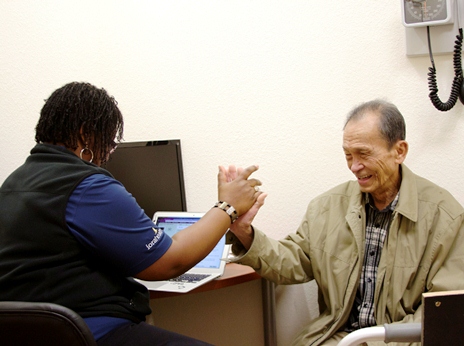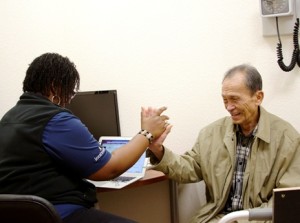
Her name was Joyce, and I had the pleasure of meeting her when she first came to my practice many years ago. Her hair was disheveled, she arrived late, and her health was a mess. Her diabetes and hypertension were way out of control, she was intermittently taking her medications, her diet was awful, she was in and out of the ER, and hadn’t been able to keep a job.
In most practices, I would have just 10 minutes to quickly scan her huge prior records and write a few prescriptions. But, I have had the fortune to build and work in a completely re-imagined set of practices through Iora Health. I was able to introduce her to a health coach, clean up her medication regimen, sign her up for some groups (which we call clubs), and keep close tabs on her through our team. I had to leave the practice to work at another location, but during a visit six months later, a doc called me over and said: “Remember Joyce? You met her on her first day here? She’s back and I want you to see her.”
I walked into the room, and she looked like a new person. Her hair was combed; her clothes were put together. Her A1c and blood pressure were in control, she was eating better, taking her medications, was back to work, had not gone to the ER in four months, and had a much more confident look about her. I looked her in the eye and asked “Joyce, congratulations! You look great. Can you tell me what we’ve done to help you?”
She thought about it and replied, “Actually, doc, it’s quite simple. My health coach and the team cared about me, they taught me to care about myself, and I didn’t want to let anyone down.”
Patient engagement isn’t an interesting nice to have; it is the core of what the healthcare system needs to do to help patients successfully manage their health. Engagement got Joyce to dramatically improve her life and health. And, I realized it was the sum of a lot of changes that allowed us to engage her in ways that her prior doctors in usual practices could not. These included:
New payment system: Most of primary care, and healthcare in general in the US, is paid fee-for-service. All we get paid for are doctor sick visits which encourages us to build systems around throughput. To engage patients we need to think about care as a continuous healing relationship. Fee-for-service is simply the wrong way to pay for relationships. At Iora, we insist on some variant of fixed fee payment like a fair risk-adjusted capitation payment for our patients so we can shift and focus on the relationship and improved outcomes.
New space design: Most doctors’ offices are designed for throughput, not engagement. Receptionists sit behind a glass partition; the patient is escorted into a small exam room too small for their loved ones to join them. The décor is sterile and at best, a large corporate hotel chain instead of a personal bed and breakfast where you feel comfortable and treated as an individual.
New process: We need to allow patients to communicate with us however they want – in person, by text, email and video chat. And, we want patients to engage with each other in groups in person and virtually. This is 2014 yet most medical practices work as if technology froze after the invention of the telephone and fax.
New staffing: We need to go way beyond just the doctor and medical assistant and include all those we need to help engage patients such as health coaches, nutritionists, social workers, therapists and others while organizing our practices to aggregate these people around our patients instead of making patients travel from office to office and repeat their information.
New IT systems: Current EHRs are at base fancy cash registers that turn the doctor into a coding clerk to maximize billing. They make the physician focus on collecting elements for upcoding rather than listening to their patients’ stories and communicating openly.
New Culture: Perhaps the most important thing is to fundamentally change the culture. It is hard to pinpoint exactly what it is, but you know it when you see it. Visitors to our practice immediately feel differently. They are in an environment where people care for each other and are cared for, and everything else works to encourage – not discourage – this.
By the end of this year, we will have almost a dozen practices across six states, and have already shown incredible performance in patient (and team) satisfaction, clinical outcomes and lower total cost of care. We know what needs to be done to engage patients, and the results are staggering. We saw with Joyce – it really works. We just need the courage to do it.
Editor’s Note: Understandably, Iora Health was a strong contender in competition for the John Q. Sherman Award for Excellence in Patient Engagement. You can learn more about this innovative model for primary care and its impact in Iora’s nomination which is featured here.






1 Comment
Fabulous work and article. I’m a big fan of Iora Health and the payment model that has allowed you to shift the focus of your work to one that is truly patient-focused.